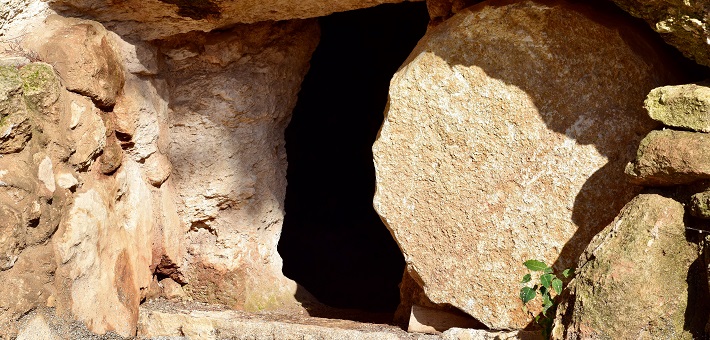Commentary on Mark 16:1-8
“Alice laughed. ‘There’s no use trying,’ she said. ‘One can’t believe impossible things.’ ‘I daresay you haven’t had much practice,’ said the Queen. ‘When I was your age, I always did it for half-an-hour a day. Why, sometimes I’ve believed as many as six impossible things before breakfast.”1
We believe impossible things. The impossibility of these beliefs is the grounding of our faith (2 Corinthians 4:18). Nevertheless, if someone told you a child in your town had been born of a virgin, what would you say? If someone told you they knew a person who had been dead for three days and was resurrected, but you never saw them with your own eyes, would you believe them? NEVER. Today shows us the unbelievable richness and joy of God’s work in the world: like the women at the tomb, it leaves us speechless.
The women at the end of Mark’s Gospel take center stage. These women—and apparently many others—have followed Jesus from Galilee (Mark 15:40). The women remained in the city through the Sabbath. Some point out their inability to attend to details, such as moving the stone from the tomb’s entrance, and others note the women’s failure to immediately share the news of Jesus’ resurrection. Life two days after a loved one’s tragic death is anything but clear; it is fuzzy at best.
I imagine the women are trying to find something to talk about—anything but the thing on their minds. Jesus’ unspeakable death leaves them few topics to engage but the weather and practical considerations of his burial. The women assume someone will be there to help them, even as they wonder who is around to help them move the stone. Maybe they are hoping one of the male disciples had hung around the city, or maybe they could compel some passerby … and then the story turns on its head.
Instead of finding Jesus’ corpse, the women encounter an angelic figure in a white robe. He tells them to not be alarmed: how could they not be? They had come to the tomb, expecting to anoint their Lord’s lifeless body. Now they are faced with an angel and a command: “Go, tell his disciples and Peter that he is going ahead of you to Galilee; there you will see him, just as he told you” (Mark 16:7).
Peter is mentioned separately from the other disciples. In Luke and in John, Peter runs to the tomb (Luke 24:12; John 20:3–7). In John, Peter is restored (John 21:15–19). While it is possible that the author of Mark imagines Peter has returned to his mother-in-law in Capernaum, it is also possible that this separation is the one Peter insisted on a few days prior: “I do not know who you are talking about” (15:66–72). The end of Mark’s Gospel presents the reader with unfinished business.
After their command to go and tell, the women represent the unfinished business of the Gospel. Instead of immediately going and telling the disciples, they flee in terror. “The writer [of Mark] places the women as midwives at the boundary of the text, ready to help hearers’ faith come to birth, expecting them to dialogue with their silence, to interpret the story, and weigh its truth claims.”2
Perhaps the women’s silence is a literary device, designed to draw the reader into the Gospel narrative. At the narrative level, this seems plausible. It might be helpful, however, to imagine what it would have felt like to receive this unbelievable news. How does one respond when the worst and best news of one’s life come so closely intertwined? It isn’t hard to imagine the jumble of emotions. We have the interpretive audacity of 2,000 years of knowing how the story goes.
The women go away from the tomb, and we do not have a report of what happened next, just like we do not have a report of what the disciples did after Jesus was crucified. Mark ends as abruptly as it begins. While everything was plain in the beginning—”The beginning of the gospel of Jesus Christ”—it is obfuscated at the end. Like the end of a movie that has no clear resolution, with everything still hanging in the balance, the audience is meant to be at the edge of their seats, waiting for what comes next. It is disorienting, and I think it is meant to be: Jesus disorients us so that we might be reoriented.
We have been so reoriented that today, when we gather to celebrate, we will shout “He is risen indeed,” as if resurrection from the dead—this incredible news—is the obvious result. As Raquel S. Lettsome indicates:
There is every reason to expect death to give way to life, even in the midst of the darkest circumstances. So, before the preacher can say ‘early Sunday morning,’ the celebration has begun. It is not based on what people did but on what God did. They believe God raised Jesus from the dead, even if they have not yet seen the LORD. They do not need to end the story. Instead, they can be a part of it, by following the resurrected one.3
Jesus has started the celebration ahead of us; he is going ahead of us, preparing the way. Grief gives way to joy, and terror and amazement flow out in nonsensical words as the first Easter sermon is preached: “He is risen; he is not here.” God is out loose in the world, and now the message of Christ’s resurrection is out loose too. Perhaps we do not need to believe six impossible things before breakfast, but one will suffice: He is risen! Alleluia!
Notes
- Lewis Carroll, Through the Looking Glass and What Alice Found There (New York: Random House, 1946), 76.
- Joan L. Mitchell, Beyond Fear and SIlence: A Feminist-Literary Reading of Mark (New York: Continuum, 2001), 16.
- Raquel S. Lettsome, “The Gospel of Mark,” in The New Testament: Fortress Commentary on the Bible, ed. Margaret Aymer, Cynthia Briggs Kittredge, and David A. Sánchez (Minneapolis: Fortress Press, 2014), 213.
PRAYER OF THE DAY
Holy Lord Jesus, on this day we rejoice in your glory and stand in awe of how you have transformed this world with your dying and your rising. Receive our joyful praise. Alleluia! Amen.
HYMNS
Jesus Christ is risen today ELW 365, GG 232, H82 207, NCH 240
Christ the Lord is risen today ELW 369
CHORAL
Alleluia, Ralph Manuel


March 31, 2024